Coastal aquifers are a significant source of water for industry, drinking, public open space and a range of other uses. In coastal aquifers, dense salty water from the ocean meets the fresh water flowing out to sea below the surface of the land. This zone naturally occurs and is called the seawater interface.
The seawater interface can move inland if rainfall and groundwater recharge decline, or too much groundwater is abstracted. To maximise groundwater use without risking aquifers going saline, we need to know more about the location and movement of the seawater interface in many coastal areas.
Statewide seawater interface investigations, funded by our flagship State Groundwater Investigation Program (SGIP), are improving monitoring networks and giving us a better understanding of the seawater interface in priority areas across the state. These investigations began in 2016 and are ongoing around Western Australia.
What we are doing for these investigations
Statewide seawater interface investigations provide information, science and evidence-based advice to enable coastal groundwater resources to be used to their full potential, without going saline. The projects:
- use a combination of drilling, groundwater sampling and downhole and ground-based geophysics to measure and monitor the seawater interface
- install appropriate seawater interface monitoring in priority groundwater areas across the state
- assess new methods to effectively and efficiently investigate and monitor seawater interfaces.
So far we have:
- completed or are conducting investigations in the Cockburn, Peel Coastal, Myalup, Bunbury, Busselton-Dunsborough and Esperance areas
- begun scoping in the Broome-Skuthorpe and La Grange areas.
Key findings and how we are using the information
In the Cockburn area we have completed our assessment and have:
- mapped the location of the seawater interface
- used our new knowledge of the extent of the seawater interface to refine the seawater interface risk zone and local licensing rules in the Cockburn groundwater allocation plan
- through the monitoring so far, found that the seawater interface moves seasonally – inland in summer and receding during winter/spring
- continued to monitor the seawater interface to assess any inland progression from abstraction and climate change.
Find a summary of the results and available reports.
In the Peel Coastal area we have:
- found hypersaline groundwater related to Peel Inlet in the east of the area that may be a higher risk to resource condition than seawater (ongoing monitoring is required to determine if this hypersaline groundwater is mobile)
- captured preliminary monitoring and logged data to indicate the ocean-side seawater interface has moved inland (ongoing monitoring is required to confirm if this is seasonal or if there is persistent inland seawater interface movement).
In the Esperance area, we have:
- identified the thickness and extent of fresh water in the superficial aquifer.
Findings from these investigations will help us manage seawater intrusion risks as part of allocation planning and licensing in priority areas around the state.
Where to get more details
Find a summary of our results and available information in the Cockburn seawater interface project
To request copies of the internal technical reports for this investigation, email groundwater.info@dwer.wa.gov.au
Reports completed to date include:
- Cockburn seawater interface project – Bore completion report, HR408 (DWER 2019)
- Cockburn seawater interface project – Priority area assessment, HR443 (DWER 2024)
- Peel seawater interface project – Bore completion report, HR409 (DWER 2020)
- Esperance seawater interface project – Bore completion report, HR418 (DWER 2020)
- Bunbury to Dunsborough seawater interface project – Bore completion report, HR428 (DWER 2023)
- Myalup seawater interface project – Bore completion report, HR440 (DWER 2024)
Access data from the monitoring bores installed as part of this investigation at our Water Information Reporting portal.
Read more about our groundwater investigations across Western Australia.



